1. Presentation
SIGFLOW analyses all network traffic. It can generate alerts, metadata, and content based on rules. Coming from different sources, these rules must describe the characteristics of the attacks to be detected as well as being optimised to reduce false positives. Gatewatcher provides a set of rules that can be downloaded from its update platform. The following paragraphs describe the steps required to provide these rules to the GCAP SIGFLOW module through the GCENTER.
The basic configuration steps are as follows:
2. GCAP Profiles

Menu: Operators > Sigflow > GCap Profiles
From this configuration interface, users will be able to apply specific policy rules. They can customise the settings from the following categories:
In order to start the detection engine on the GCap probe, the user must first apply a ruleset to it. See section Sigflow/Rulesets on creating a ruleset".
2.1. Detection Rulesets

Menu: Operators > Sigflow > GCAP Profiles
The Detection Rulesets section enables applying previously created SIGFLOW Rulesets to GCAPs paired on the GCENTER. It is also possible to configure the codebreaker module for the GCAP that includes enabling or disabling shellcode and powershell detection separately.
Note
It is necessary to generate rules for a ruleset before applying it to GCAPs. Failure to do so will result in no rules being applied.
Note
Codebreaker is not configurable via the Detection Rulesets menu with the CIE license.
**The GCAP Detection Rulesets menu enables three configuration options
Single tenant:
Assign a ruleset for all GCAP monitoring interfaces;
Enable/disable codebreaker for all GCAP monitoring interfaces.
The multi-tenant per interface:
Assign a ruleset per GCAP monitoring interface;
Enable/disable codebreaker per GCAP monitoring interface.
Multi-tenant by vlan:
Assign one ruleset per vlan;
Assign a ruleset for the default vlan for those vlans not created via the interface;
Enable/disable codebreaker per vlan;
Enable/disable codebreaker for the default vlan for those vlans not created via the interface;
Note
These configuration options are exclusive. This means that it will not be possible to apply a single tenant and multi-tenant per vlan configuration at the same time.
2.1.1. Single-tenant
Note
Changes to this tab require the GCAP configuration to be backed up and implemented via the save and apply button.
Single-tenant configuration:
Go to the
Single-tenanttab;Select a ruleset to apply to all interfaces;
Enable or disable shellcode detection for all interfaces;
Enable or disable powershell detection for all interfaces;
Apply the configuration by clicking the "save" button.
2.1.2. Multi-tenant by interface
The multi-tenant by interface enables applying a single-tenant configuration for each of the GCAP interfaces, thus having a different supervision per interface. Indeed, it is possible to apply a different SIGFLOW ruleset, as well as to configure codebreaker for each of the GCAP interfaces.
Note
It is advisable to optimise the SIGFLOW ruleset in advance before choosing this configuration option. The rules must be adapted to the monitored environment.
Note
It is necessary to verify whether multiple monitoring interfaces are enabled on the GCAP prior to applying a multi-tenant by interface configuration.
Note
Changes to this tab require the GCAP configuration to be backed up and implemented via the save and apply button.
Note
Only activated monitoring interfaces appear in the GCENTER interface.
Configuring multi-tenant by interface:
Go to the
Multi-tenant by interfacetab;Select a ruleset to apply for each interface;
Enable or disable shellcode detection for each interface;
Enable or disable powershells detection for each interface;
Apply the configuration by clicking the "save" button.
Configuration example:
interface mon0:
Ruleset named "Test-mon0",
Enabling shellcode/powershell detection.
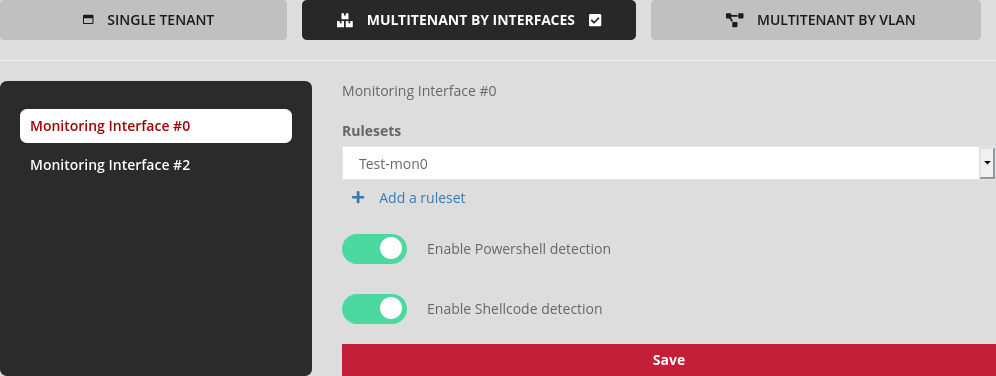
interface mon2:
Ruleset named "Test-mon2",
Disable shellcode/powershell detection.

2.1.3. Multi-tenant by vlan
The multi-tenant by vlan enables a configuration to be applied for each vlan previously created in the interface and to have distinct monitoring on different networks. Thus, it is possible to apply a SIGFLOW ruleset as well as to configure codebreaker independently for each vlan. A vlan named "default" is created as standard in the interface. It enables a SIGFLOW ruleset to be applied and codebreaker to be configured for all vlans not explicitly specified in the interface.
Note
It is advisable to optimise the SIGFLOW ruleset in advance before choosing this configuration option. The rules must be adapted to the monitored environment.
Note
Changes to this tab require the GCAP configuration to be backed up and implemented via the save and apply button.
Configuring multi-tenant by vlan:
Go to the
Multi-tenant by vlantab;Select a ruleset to apply to the default vlan;
Enable or disable shellcode detection for the default vlan;
Enable or disable powershell detection for vlan "default";
Create as many vlans as necessary via the "Add" button;
The vlan name must match the vlan number between 0 and 4096;
Then select a ruleset to apply to each vlan;
Enable or disable shellcode detection for each vlan;
Enable or disable powershell detection for each vlan;
Apply the configuration by clicking the "save" button.
Configuration example:
vlan "default":
Ruleset named "Test-default",
Enabling shellcode/powershell detection.

vlan "110":
Ruleset named "Test-vlan110",
Disable shellcode/powershell detection.
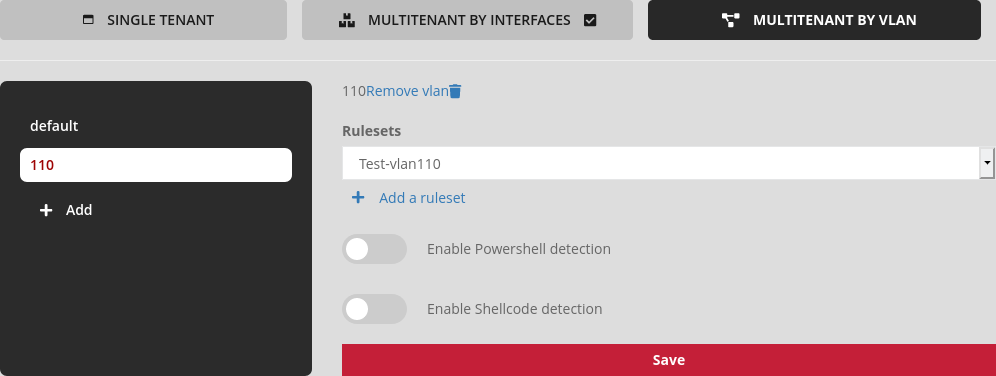
2.2. Base variables

Menu: Operators > Sigflow > GCAP Profiles
The Base variables section enable the operator to adjust the capture parameters of the probe using the advanced Suricata functions configurable from the GCENTER. Changes to this configuration have an impact on the alerts sent from the GCAP probe to the GCENTER. Enabling certain options will enable the sending of alerts, anomalies, metadata, file information, and protocol-specific records.
Alerts are records of events triggered by the matching of a rule with network traffic. An alert will be created with associated metadata, such as the application layer record (HTTP, DNS, etc).
The menu is divided into three sections:
General
Stream
Parsing
2.2.1. Base Variables - General
The Base Variables - General tab enables configuring the advanced settings of the GCAP probe (Suricata).
Note
Changes to this tab require the GCAP configuration to be backed up and implemented via the save and apply button.
The default values for variables on the general tab:
| Variables | Values |
|---|---|
| file_resend_interval | 86400s |
| files_hash | ['md5'] |
| flow_memcap | 17179869184 Bytes |
| flow_prealloc | 1048576 |
| ftp_memcap | 10485760 Bytes |
| http_body | Disabled |
| http_body_printable | Disabled |
| max_pending_packets | 4096 |
| packet | Enabled |
| payload | Enabled |
| payload_buffer_size | 4096 Bytes |
| payload_printable | Enabled |
| smb_stream_depth | 10485760 Bytes |
| xff_deployment | reverse |
| xff_enable | Enabled |
| xff_header | X-Forwarded-For |
| xff_mode | extra-data |
List of variables on the General tab:
File resend interval (seconds):** time frame in seconds in which, if an identical file is sighted on the network, it will not be resent to the GCENTER by the GCAP. Only the metadata will be sent with the Replica field set to True. After this time interval, if the same file is seen on the network, it will be sent back to the GCENTER.
Max pending packets: Number of simultaneous packets the SURICATA engine can handle. This can range from one packet to tens of thousands of packets. This parameter will have an impact on performance and memory (RAM) usage. A high number of packets being processed enables better performance, more memory to be used, and vice versa. Choosing a low number of packets being processed, while having multiple CPU cores, may result in not using the full capacity of the probe. Example: using a single core while having three packets waiting to be processed.
Enable XFF: Enable the HTTP X-Forwarded-For header management by adding a new field or by overwriting the source or destination IP address (depending on the direction of the flow) with the IP indicated in this header. The behaviour, either adding a field or overwriting, is handled by the XFF mode directive. This directive is helpful when processing flows behind a reverse proxy for example.
XFF mode: Expected behaviour when XFF is activated. Two types of operating modes are available, extra-data or overwrite. Note that in 'overwrite' mode, if the IP address reported in the HTTP X-Forwarded-For header is a different version of the received packet, then it will switch to 'extra-data' mode.
XFF deployment: XFF deployment type. Two types of deployment are available: reverse or forward. In a reverse deployment, the IP address used is the last one, while in a forward deployment, the IP address used is the first one.
Xff header: This is the name of the HTTP header in which the actual IP address is present. If more than one IP address is present, the last IP address will be the one used.
Payload: Adds a field containing the base64 encoded payload of a flow triggering an alert.
Payload buffer size: maximum size of the payload buffer to be added to the alert.
Payload printable: Adds a field containing the (Payload) in ASCII (so-called 'human') format.
Packet: dump of the captured base64 encoded package.
HTTP body: Adds a field containing the body of base64 encoded HTTP requests. This parameter requires metadata to work.
HTTP body printable: Adds a field containing the body of HTTP requests in ASCII (so-called 'human') format. This parameter requires metadata to work.
Flow memcap: maximum allocation for byte flows.
Flow prealloc: initial flow allocation.
FTP memcap (B): 'maximum allocation for byte flows.
SMB Stream Depth (B): The size of the files that can be restored and saved depends on the value in megabytes. Beyond this value, no reconstruction will be undertaken. If this value is reached, the file may be truncated and not entirely stored. This implies that after this value, the SMB session will no longer be tracked. Additionally, negative values disable the option. Setting this value to 0 enables any file size to be stored.
Files hash: Enables selecting the hash function for rebuilt files (md5, sha1, and sha256). By default, md5 is selected. The sha256 hash will in all cases be added by the [Malcore] module (malcore.html#presentation).
2.2.2. Base Variables - Stream
Caution
Changing the settings in this section may cause the TRACKWATCH solution to malfunction. This section is reserved for support staff and advanced users.
Only the "file_store_stream_depth_mb" variable can be modified, never exceeding 100 MB.
The Base Variables - Stream tab enables configuring the file reconstruction parameters as well as the Stream-engine module of the GCAP probe (Suricata). The Stream-engine module of the probe enables monitoring the TCP connections.
Note
Changes to this tab require the GCAP configuration to be backed up and implemented via the save and apply button.
The engine consists of two parts:
Stream-tracking engine: Enables tracking the TCP connection status;
Reassembly-engine: Reassembles the flow for analysis by Suricata.
The default values for variables on the stream tab:
| Variables | Values |
|---|---|
| file_store_stream_depth_enable | Enabled |
| file_store_stream_depth_mb | 10 MegaBytes |
| stream_memcap_b | 32000000000 Bytes |
| stream_prealloc_sessions | 1000000 |
| stream_reassembly_depth_mb | 10 MegaBytes |
| stream_reassembly_memcap_b | 16000000000 Bytes |
| stream_reassembly_randomize_chunk_size | Enabled |
| stream_reassembly_toclient_chunk_size_b | 2560 Bytes |
| stream_reassembly_toserver_chunk_size_b | 2560 Bytes |
List of variables on the Stream tab:
Enable File-Store stream depth: Enables control of the stored file size.
File-store stream depth (Mb): Sets the maximum size of files that can be restored and saved in megabytes. If this value is reached, the file may be truncated and not entirely stored. This implies that after this value, the HTTP session will no longer be tracked. A negative value disables the option. A value of 0 enables any file size to be stored. If this option is not enabled, then the value of 'Stream reassembly depth (Mb)' will be taken into account.
Stream memcap (B): This value is the maximum value in bytes allocated to TCP session tracking. In order to avoid a lack of resources, a memcap can be used to restrict the memory used.
Stream Prealloc sessions: This is the amount of sessions the SURICATA engine must hold in memory. This engine works independently of packet processing. It has a management thread that sets this value inside the memcap to allocate memory. The option enables SURICATA to avoid being overloaded by the fast creation of sessions. It instructs it to keep a certain number of sessions ready in memory. It specifies the number of elements to be pre-allocated when the software boots. This reduces the cost of in-running allocations at the expense of the software's initial memory usage.
Stream reassembly memcap (B) The stream reassembly engine must retain segments of data in memory in order to rebuild it. To avoid resource constraints, a memcap is used to limit the memory used. This option is the maximum amount of bytes the flow engine can use to restore a file.
Enable the randomizable of chunks size: The purpose of this setting is to avoid making chunk recovery too predictable. For this purpose, their size will be modified by a random factor that will be added.
Stream reassembly depth (Mb)** This is the size of the network flow in megabytes. The act of reassembling a data flow is a very important operation that can be controlled using the 'depth' concept. The default value is a parameter that can be overridden by the protocol analysers performing the file extraction. The inspection will be ignored if this value is reached for a particular flow. Setting this value to 0 enables any flow size to be stored.
Stream reassembly to server chunk size (B) The reconstruction of a data stream is carried out in chunks. The size of these chunks is to be set in this field so that the flow is inspected and rebuilt using this value.
Stream reassembly to client chunk size (B) The reconstruction of a data stream is carried out in chunks. The size of these chunks is to be set in this field so that the flow is inspected and rebuilt according to it.
2.2.3. Base Variables - Parsing
The Base Variables - Parsing tab enables configuring the parsing and logging of protocols used by the GCAP probe. Protocols that can be parsed and logged are present in the GCenter interface. In the event a GCAP probe is one version ahead of the GCenter, it is possible that some protocols have been added.
This is discussed in more detail in the [GCAP] documentation (https://docs.gatewatcher.com/gcap.html) in the section Detection Engine > 3. Selecting the protocols being analysed.
Terminology for parsing and logging:
Parsing consists of enabling SIGFLOW signature detection for a given protocol. Indeed, if the latter is activated for a protocol, then the flow identified by a signature will raise a SIGFLOW alert in the Kibana dashboard.
The logging consists in enabling the generation of metadata for a given protocol. Indeed, if the latter is activated for a protocol, then each observed session will raise an alert for that protocol in the Kibana dashboard.
Note
The protocols' default settings vary depending on the GCAP profile used.
Note
Changes to this tab require the GCAP configuration to be backed up and implemented via the save and apply button.
Here is the list of protocols that can be configured with the parsing option:
dcerpc
dnp3
dns_udp
dns_tcp
ftp
http
modbus
smb
smtp
ssh
tls
dhcp
ikev2
krb5
nfs
ntp
tftp
Here is the list of protocols that can be configured with the logging option:
http
dns_udp
dns_tcp
tls
smtp
smb
ssh
netflow
dnp3
ftp
dhcp
ikev2
krb5
nfs
tftp
Here is the default configuration of the parsing option for each protocol according to the profile used:
| Protocols | Minimal | Balanced | LPM | Paranoid | Intuitio |
|---|---|---|---|---|---|
| dcerpc | Disabled | Disabled | Disabled | Enabled | Disabled |
| dnp3 | Disabled | Disabled | Disabled | Enabled | Disabled |
| dns_udp | Disabled | Enabled | Enabled | Enabled | Enabled |
| dns_tcp | Disabled | Enabled | Enabled | Enabled | Enabled |
| ftp | Disabled | Enabled | Enabled | Enabled | Enabled |
| http | Enabled | Enabled | Enabled | Enabled | Enabled |
| modbus | Disabled | Disabled | Disabled | Enabled | Disabled |
| smb | Disabled | Enabled | Disabled | Enabled | Enabled |
| smtp | Enabled | Enabled | Enabled | Enabled | Enabled |
| ssh | Disabled | Enabled | Disabled | Enabled | Enabled |
| tls | Disabled | Enabled | Enabled | Enabled | Enabled |
| dhcp | Disabled | Enabled | Disabled | Enabled | Enabled |
| ikev2 | Disabled | Disabled | Disabled | Enabled | Disabled |
| krb5 | Disabled | Enabled | Disabled | Enabled | Enabled |
| nfs | Disabled | Enabled | Disabled | Enabled | Enabled |
| ntp | Disabled | Enabled | Disabled | Enabled | Disabled |
| tftp | Disabled | Enabled | Disabled | Enabled | Enabled |
Here is the default configuration of the logging option for each protocol according to the profile used:
| Protocols | Minimal | Balanced | LPM | Paranoid | Intuitio |
|---|---|---|---|---|---|
| http | Disabled | Enabled | Enabled | Enabled | Enabled |
| dns_udp | Disabled | Enabled | Enabled | Enabled | Enabled |
| dns_tcp | Disabled | Enabled | Enabled | Enabled | Enabled |
| tls | Disabled | Enabled | Enabled | Enabled | Enabled |
| smtp | Disabled | Enabled | Enabled | Enabled | Enabled |
| smb | Disabled | Enabled | Disabled | Enabled | Enabled |
| ssh | Disabled | Enabled | Disabled | Enabled | Enabled |
| netflow | Disabled | Disabled | Disabled | Enabled | Disabled |
| dnp3 | Disabled | Disabled | Disabled | Enabled | Disabled |
| ftp | Disabled | Enabled | Enabled | Enabled | Enabled |
| dhcp | Disabled | Enabled | Disabled | Enabled | Enabled |
| ikev2 | Disabled | Disabled | Disabled | Enabled | Disabled |
| krb5 | Disabled | Enabled | Disabled | Enabled | Enabled |
| nfs | Disabled | Enabled | Disabled | Enabled | Enabled |
| tftp | Disabled | Enabled | Disabled | Enabled | Enabled |
In addition to these protocols, it is also possible to generate NetFlow data.
Warning
Enabling NetFlow data generation will create a great deal of metadata
2.3. Net variables

Menu: Operators > Sigflow > GCAP Profiles
The Net variables section enables the operator to define the network variables used in the sigflow rules.
note:: Changes to this section require the GCAP configuration to be backed up and implemented via the save and apply button.
In the structure of a SIGFLOW rule, just after 'alert' and the protocol keyword, it is possible to use variables that will enable defining groups of IP addresses.
In the following example:
alert tcp $EXTERNAL_NET any -> $HOME_NET any (msg:”GPL SCAN NULL”; flow:stateless; ack:0; \
flags:0; seq:0; reference:arachnids,4; classtype:attempted-recon; sid:2100623; rev:7;)
These flows must go from $HOME_NET to $EXTERNAL_NET.
The first part $HOME_NET is the source, the second $EXTERNAL_NET is the destination. With the source and destination, you specify the origin of the traffic and the location of the traffic, respectively. You can assign IP addresses (IPv4 and IPv6 are supported) and IP ranges. These parameters will be used instead of variables in the detection rules.
This section enables you to define the contents of these variables.
To implement these changes, it is necessary to click on the Save and Apply button.
The rule adapts to the needs. It can change depending on the parameter selected in the drop-down menu of each environment. The 'list', 'default (equal to HOME_NET)' and 'exclude (opposite of HOME_NET)' options respectively enable the action of the rule to be defined in relation to a group of addresses, in relation to the addresses specified in the HOME_NET environment, or in relation to all the addresses not part of the HOME_NET environment.
It is not necessary to define an address for each of the existing variables. By default, if nothing is specified, this is equivalent to applying the rule to all traffic.
The default configuration used:
| Variables | Values |
|---|---|
| home_net | [] |
| external_net | [] |
| http_servers | default |
| smtp_servers | default |
| sql_servers | default |
| dns_servers | default |
| telnet_servers | default |
| aim_servers | default |
| dnp3_servers | default |
| dnp3_clients | default |
| modbus_servers | default |
| modbus_clients | default |
| enip_servers | default |
| enip_clients | default |
| dnp3_server | default |
| dnp3_client | default |
| modbus_server | default |
| modbus_client | default |
| enip_server | default |
| enip_client | default |
2.4. Flow timeouts

Menu: Operators > Sigflow > GCAP Profiles
Caution
Changing the settings in this section may cause the TRACKWATCH solution to malfunction. This section is reserved for support staff and advanced users.
The Flow timeouts section enables configuring the time in seconds that Suricata retains a flow in memory depending on its status. The udp, tcp, and icmp protocols are configurable.
Note
Changes to this section require the GCAP configuration to be backed up and implemented via the save and apply button.
The default configuration used depending on the protocol (all values are in seconds):
| protocol | new | established | closed | emergency_new | emergency_established | emergency_closed |
|---|---|---|---|---|---|---|
| udp | 30 | 300 | - | 10 | 100 | - |
| tcp | 30 | 300 | 0 | 10 | 100 | 0 |
| icmp | 30 | 300 | - | 10 | 100 | - |
| default | 30 | 300 | - | 10 | 100 | - |
For each protocol, there are different statuses in which a flow can be found:
TCP protocol:
New: The period of time during which the connection is established. This field is the time in seconds after the last activity of this flow in this status type.
Established: The period of time during which the data transfer is taking place. This field is the time in seconds after the last activity of this flow in this status type.
Closed: The time period during which the connection is terminated. This field is the time in seconds after the last activity of this flow in this status type.
UDP and ICMP protocols:
New: The status during which packets are sent from a single direction. This field is the time in seconds after the last activity of this flow in this status type.
Established: The status during which packets are sent in both directions. This field is the time in seconds after the last activity of this flow in this status type.
**Emergency_new', 'Emergency_established' and 'Emergency_closed' are the emergency modes for the three states of TCP, UDP, and ICMP.
2.5. Files rules management

Menu: Operators > Sigflow > GCAP Profiles
The Files rules management section enables configuring the file types that the probe will retrieve for a given protocol. The supported protocols are: HTTP, SMTP, SMB, NFS, and FTP. Files are extracted and then saved to disk with metadata. This includes information such as timestamp, source/destination IP address, protocol, source/destination port, size, and md5sum, etc. File extraction works in parallel with the SIGFLOW signatures defined for these same protocols. Each line in the Files rules management section corresponds to an extraction rule for a file type.
Note
Too many file extraction rules can have a significant impact on the performance of the probe.
Note
Changes to this section require the GCAP configuration to be backed up and implemented via the save and apply button.
Here is the list of fields that can be configured for an entry in the Files rules management: section
Protocol: Enables selecting the protocol for which the file will be extracted from among: HTTP, SMTP, SMB, NFS, and FTP.
Type: Enables defining the way suricata recognises the file:
extension: Corresponds to the file extension.
filemagic: Corresponds to the type of extracted file. The file command under linux enables obtaining this information:
shell
xxx@debian:~$ file ~/Téléchargements/xxx.exe
/home/xxx/Téléchargements/xxx.exe: PE32 executable (console) Intel 80386, for MS Windows
Value: The identifier of the file that will be rebuilt according to the previously configured type:
Type extension:
Fichier javascript: js,
Windows executable file: exe.
filemagic type:
Javascript file: Javascript,
Windows executable file: PE32 executable.
Enable** and Delete are the tick boxes for activating and removing the file extraction rule respectively.
The rules applied depending on the GCAP profile used:
| Protocols | Values | Minimal | Balanced | LPM | Paranoid | Intuitio |
|---|---|---|---|---|---|---|
| http | Microsoft Excel | Disabled | Enabled | Enabled | Enabled | Enabled |
| http | Microsoft Word | Disabled | Enabled | Enabled | Enabled | Enabled |
| http | Microsoft PowerPoint | Disabled | Enabled | Enabled | Enabled | Enabled |
| http | Composite Document File V2 | Disabled | Enabled | Enabled | Enabled | Enabled |
| http | Microsoft Office Document | Disabled | Enabled | Enabled | Enabled | Enabled |
| http | Microsoft OOXML | Disabled | Enabled | Enabled | Enabled | Enabled |
| http | 7-zip archive data | Disabled | Enabled | Enabled | Enabled | Enabled |
| http | PDF document | Disabled | Enabled | Enabled | Enabled | Enabled |
| http | ELF | Disabled | Enabled | Enabled | Enabled | Enabled |
| http | Microsoft Cabinet archive data | Disabled | Enabled | Enabled | Enabled | Enabled |
| http | PE32 executable (DLL) | Disabled | Enabled | Enabled | Enabled | Enabled |
| http | PE32 executable | Disabled | Enabled | Enabled | Enabled | Enabled |
| http | gzip compressed data | Disabled | Enabled | Enabled | Enabled | Enabled |
| http | RAR archive data | Disabled | Enabled | Enabled | Enabled | Enabled |
| http | Zip archive data | Disabled | Enabled | Enabled | Enabled | Enabled |
| http | POSIX tar archive | Disabled | Enabled | Enabled | Enabled | Enabled |
| http | DOS batch | Disabled | Enabled | Enabled | Enabled | Enabled |
| http | MS-DOS executable | Disabled | Enabled | Enabled | Enabled | Enabled |
| http | Java archive data | Disabled | Enabled | Enabled | Enabled | Enabled |
| http | Macromedia Flash | Disabled | Enabled | Enabled | Enabled | Enabled |
| http | OS/2 REXX batch file | Disabled | Enabled | Enabled | Enabled | Enabled |
| http | COM executable | Disabled | Enabled | Enabled | Enabled | Enabled |
| http | Node.js script text | Disabled | Enabled | Enabled | Enabled | Enabled |
| http | MS Windows shortcut | Disabled | Enabled | Enabled | Enabled | Enabled |
| http | PE32+ executable | Disabled | Enabled | Enabled | Enabled | Enabled |
| http | OpenDocument | Disabled | Enabled | Enabled | Enabled | Enabled |
| http | Mach-O | Disabled | Enabled | Enabled | Enabled | Enabled |
| http | Javascript | Disabled | Enabled | Disabled | Enabled | Enabled |
| smtp | Microsoft Excel | Disabled | Enabled | Enabled | Enabled | Enabled |
| smtp | Microsoft Word | Disabled | Enabled | Enabled | Enabled | Enabled |
| smtp | Microsoft PowerPoint | Disabled | Enabled | Enabled | Enabled | Enabled |
| smtp | Composite Document File V2 | Disabled | Enabled | Enabled | Enabled | Enabled |
| smtp | Microsoft Office Document | Disabled | Enabled | Enabled | Enabled | Enabled |
| smtp | Microsoft OOXML | Disabled | Enabled | Enabled | Enabled | Enabled |
| smtp | 7-zip archive data | Disabled | Enabled | Enabled | Enabled | Enabled |
| smtp | PDF document | Disabled | Enabled | Enabled | Enabled | Enabled |
| smtp | ELF | Disabled | Enabled | Enabled | Enabled | Enabled |
| smtp | Microsoft Cabinet archive data | Disabled | Enabled | Enabled | Enabled | Enabled |
| smtp | PE32 executable (DLL) | Disabled | Enabled | Enabled | Enabled | Enabled |
| smtp | PE32 executable | Disabled | Enabled | Enabled | Enabled | Enabled |
| smtp | gzip compressed data | Disabled | Enabled | Enabled | Enabled | Enabled |
| smtp | RAR archive data | Disabled | Enabled | Enabled | Enabled | Enabled |
| smtp | Zip archive data | Disabled | Enabled | Enabled | Enabled | Enabled |
| smtp | POSIX tar archive | Disabled | Enabled | Enabled | Enabled | Enabled |
| smtp | DOS batch | Disabled | Enabled | Enabled | Enabled | Enabled |
| smtp | MS-DOS executable | Disabled | Enabled | Enabled | Enabled | Enabled |
| smtp | Java archive data | Disabled | Enabled | Enabled | Enabled | Enabled |
| smtp | Macromedia Flash | Disabled | Enabled | Enabled | Enabled | Enabled |
| smtp | OS/2 REXX batch file | Disabled | Enabled | Enabled | Enabled | Enabled |
| smtp | COM executable | Disabled | Enabled | Enabled | Enabled | Enabled |
| smtp | Node.js script text | Disabled | Enabled | Enabled | Enabled | Enabled |
| smtp | MS Windows shortcut | Disabled | Enabled | Enabled | Enabled | Enabled |
| smtp | PE32+ executable | Disabled | Enabled | Enabled | Enabled | Enabled |
| smtp | OpenDocument | Disabled | Enabled | Enabled | Enabled | Enabled |
| smtp | Mach-O | Disabled | Enabled | Enabled | Enabled | Enabled |
| smtp | Javascript | Disabled | Enabled | Disabled | Enabled | Enabled |
| ftp | Microsoft Excel | Disabled | Enabled | Enabled | Enabled | Enabled |
| ftp | Microsoft Word | Disabled | Enabled | Enabled | Enabled | Enabled |
| ftp | Microsoft PowerPoint | Disabled | Enabled | Enabled | Enabled | Enabled |
| ftp | Composite Document File V2 | Disabled | Enabled | Enabled | Enabled | Enabled |
| ftp | Microsoft Office Document | Disabled | Enabled | Enabled | Enabled | Enabled |
| ftp | Microsoft OOXML | Disabled | Enabled | Enabled | Enabled | Enabled |
| ftp | 7-zip archive data | Disabled | Enabled | Enabled | Enabled | Enabled |
| ftp | PDF document | Disabled | Enabled | Enabled | Enabled | Enabled |
| ftp | ELF | Disabled | Enabled | Enabled | Enabled | Enabled |
| ftp | Microsoft Cabinet archive data | Disabled | Enabled | Enabled | Enabled | Enabled |
| ftp | PE32 executable (DLL) | Disabled | Enabled | Enabled | Enabled | Enabled |
| ftp | PE32 executable | Disabled | Enabled | Enabled | Enabled | Enabled |
| ftp | gzip compressed data | Disabled | Enabled | Enabled | Enabled | Enabled |
| ftp | RAR archive data | Disabled | Enabled | Enabled | Enabled | Enabled |
| ftp | Zip archive data | Disabled | Enabled | Enabled | Enabled | Enabled |
| ftp | POSIX tar archive | Disabled | Enabled | Enabled | Enabled | Enabled |
| ftp | DOS batch | Disabled | Enabled | Enabled | Enabled | Enabled |
| ftp | MS-DOS executable | Disabled | Enabled | Enabled | Enabled | Enabled |
| ftp | Java archive data | Disabled | Enabled | Enabled | Enabled | Enabled |
| ftp | Macromedia Flash | Disabled | Enabled | Enabled | Enabled | Enabled |
| ftp | OS/2 REXX batch file | Disabled | Enabled | Enabled | Enabled | Enabled |
| ftp | COM executable | Disabled | Enabled | Enabled | Enabled | Enabled |
| ftp | Node.js script text | Disabled | Enabled | Enabled | Enabled | Enabled |
| ftp | MS Windows shortcut | Disabled | Enabled | Enabled | Enabled | Enabled |
| ftp | PE32+ executable | Disabled | Enabled | Enabled | Enabled | Enabled |
| ftp | OpenDocument | Disabled | Enabled | Enabled | Enabled | Enabled |
| ftp | Mach-O | Disabled | Enabled | Enabled | Enabled | Enabled |
| ftp | Javascript | Disabled | Enabled | Disabled | Enabled | Enabled |
| nfs | Microsoft Excel | Disabled | Disabled | Disabled | Enabled | Enabled |
| nfs | Microsoft Word | Disabled | Disabled | Disabled | Enabled | Enabled |
| nfs | Microsoft PowerPoint | Disabled | Disabled | Disabled | Enabled | Enabled |
| nfs | Composite Document File V2 | Disabled | Disabled | Disabled | Enabled | Enabled |
| nfs | Microsoft Office Document | Disabled | Disabled | Disabled | Enabled | Enabled |
| nfs | Microsoft OOXML | Disabled | Disabled | Disabled | Enabled | Enabled |
| nfs | 7-zip archive data | Disabled | Disabled | Disabled | Enabled | Enabled |
| nfs | PDF document | Disabled | Disabled | Disabled | Enabled | Enabled |
| nfs | ELF | Disabled | Disabled | Disabled | Enabled | Enabled |
| nfs | Microsoft Cabinet archive data | Disabled | Disabled | Disabled | Enabled | Enabled |
| nfs | PE32 executable (DLL) | Disabled | Disabled | Disabled | Enabled | Enabled |
| nfs | PE32 executable | Disabled | Disabled | Disabled | Enabled | Enabled |
| nfs | gzip compressed data | Disabled | Disabled | Disabled | Enabled | Enabled |
| nfs | RAR archive data | Disabled | Disabled | Disabled | Enabled | Enabled |
| nfs | Zip archive data | Disabled | Disabled | Disabled | Enabled | Enabled |
| nfs | POSIX tar archive | Disabled | Disabled | Disabled | Enabled | Enabled |
| nfs | DOS batch | Disabled | Disabled | Disabled | Enabled | Enabled |
| nfs | MS-DOS executable | Disabled | Disabled | Disabled | Enabled | Enabled |
| nfs | Java archive data | Disabled | Disabled | Disabled | Enabled | Enabled |
| nfs | Macromedia Flash | Disabled | Disabled | Disabled | Enabled | Enabled |
| nfs | OS/2 REXX batch file | Disabled | Disabled | Disabled | Enabled | Enabled |
| nfs | COM executable | Disabled | Disabled | Disabled | Enabled | Enabled |
| nfs | Node.js script text | Disabled | Disabled | Disabled | Enabled | Enabled |
| nfs | MS Windows shortcut | Disabled | Disabled | Disabled | Enabled | Enabled |
| nfs | PE32+ executable | Disabled | Disabled | Disabled | Enabled | Enabled |
| nfs | OpenDocument | Disabled | Disabled | Disabled | Enabled | Enabled |
| nfs | Mach-O | Disabled | Disabled | Disabled | Enabled | Enabled |
| nfs | Javascript | Disabled | Disabled | Disabled | Enabled | Enabled |
| smb | Microsoft Excel | Disabled | Disabled | Disabled | Enabled | Enabled |
| smb | Microsoft Word | Disabled | Disabled | Disabled | Enabled | Enabled |
| smb | Microsoft PowerPoint | Disabled | Disabled | Disabled | Enabled | Enabled |
| smb | Composite Document File V2 | Disabled | Disabled | Disabled | Enabled | Enabled |
| smb | Microsoft Office Document | Disabled | Disabled | Disabled | Enabled | Enabled |
| smb | Microsoft OOXML | Disabled | Disabled | Disabled | Enabled | Enabled |
| smb | 7-zip archive data | Disabled | Disabled | Disabled | Enabled | Enabled |
| smb | PDF document | Disabled | Disabled | Disabled | Enabled | Enabled |
| smb | ELF | Disabled | Disabled | Disabled | Enabled | Enabled |
| smb | Microsoft Cabinet archive data | Disabled | Disabled | Disabled | Enabled | Enabled |
| smb | PE32 executable (DLL) | Disabled | Disabled | Disabled | Enabled | Enabled |
| smb | PE32 executable | Disabled | Disabled | Disabled | Enabled | Enabled |
| smb | gzip compressed data | Disabled | Disabled | Disabled | Enabled | Enabled |
| smb | RAR archive data | Disabled | Disabled | Disabled | Enabled | Enabled |
| smb | Zip archive data | Disabled | Disabled | Disabled | Enabled | Enabled |
| smb | POSIX tar archive | Disabled | Disabled | Disabled | Enabled | Enabled |
| smb | DOS batch | Disabled | Disabled | Disabled | Enabled | Enabled |
| smb | MS-DOS executable | Disabled | Disabled | Disabled | Enabled | Enabled |
| smb | Java archive data | Disabled | Disabled | Disabled | Enabled | Enabled |
| smb | Macromedia Flash | Disabled | Disabled | Disabled | Enabled | Enabled |
| smb | OS/2 REXX batch file | Disabled | Disabled | Disabled | Enabled | Enabled |
| smb | COM executable | Disabled | Disabled | Disabled | Enabled | Enabled |
| smb | Node.js script text | Disabled | Disabled | Disabled | Enabled | Enabled |
| smb | MS Windows shortcut | Disabled | Disabled | Disabled | Enabled | Enabled |
| smb | PE32+ executable | Disabled | Disabled | Disabled | Enabled | Enabled |
| smb | OpenDocument | Disabled | Disabled | Disabled | Enabled | Enabled |
| smb | Mach-O | Disabled | Disabled | Disabled | Enabled | Enabled |
| smb | Javascript | Disabled | Disabled | Disabled | Enabled | Enabled |
2.6. Packet filtering

Menu: Operators > Sigflow > GCAP Profiles
Packet filtering enables the operator to adjust the capture parameters of the detection probe using Sigflow's advanced functions.
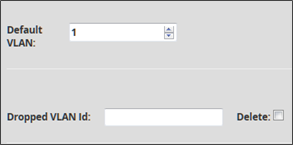
The purpose of this feature is to act directly on the TRACKWATCH capture device by modifying the packet acquisition method using Barkeley Packet Filter (BPF). Traffic will therefore be ignored for a given VLAN ID in the 'Dropped VLAN Id' field.
The default VLAN number is set on the GCENTER web interface in 'Default VLAN'. By default, this value is 1. Once the VLAN is set, a window appears allowing the operator to add network information about the traffic they want to remove from their notifications.
The operator can remove a filter rule via the Delete box. The changes are recorded when the form is validated by clicking on the Save button. However, in order to implement them it will be necessary to click on the Save and Apply button on the configuration page.
3. Rules management
The signatures of the Sigflow engine are structured in the following way:
A list of sources providing signatures
A list of signatures capable of adapting to the needs of the environment to be monitored
A list of Ruleset enabling signatures to be linked to their sources and a GCAP
3.1. Sources

Menu: Operators > Sigflow > Sources
Sources enable reporting on the locations where signatures are made available.
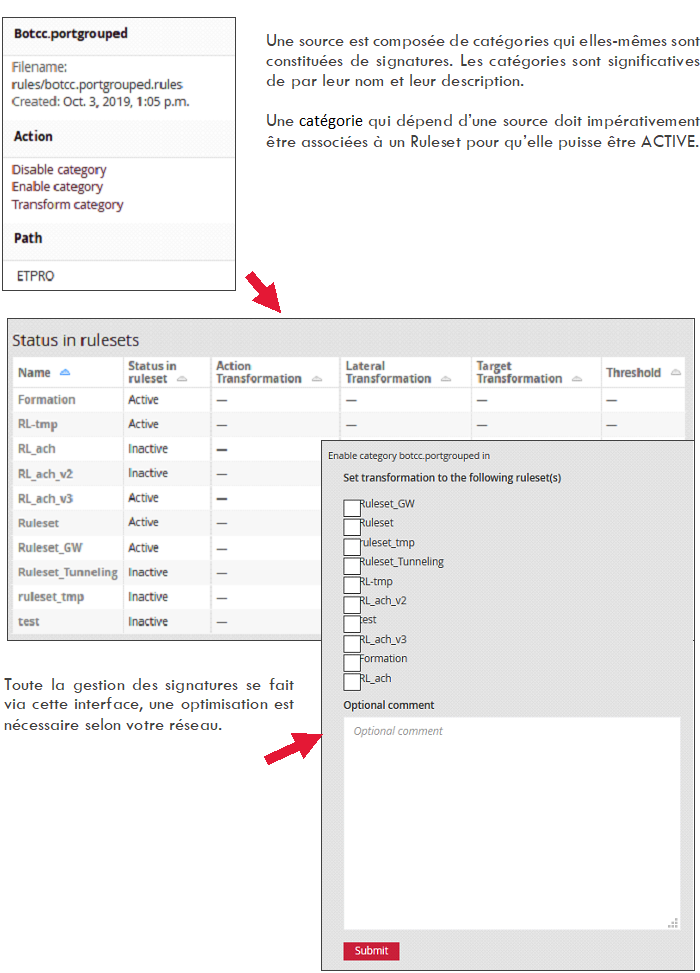

Once downloaded and unpacked, the rules need to be added to the GCENTER interface.

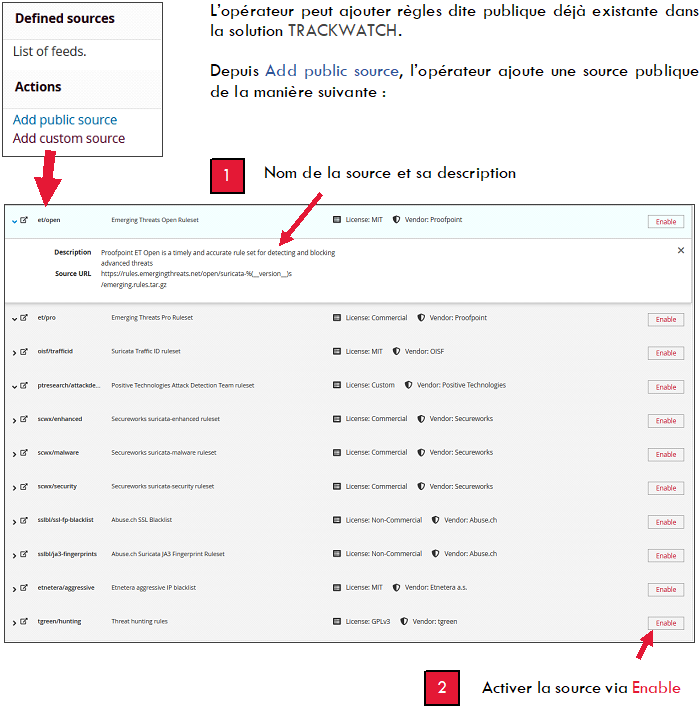
Once the rules are added, the operator can directly assign this source to different Rulesets
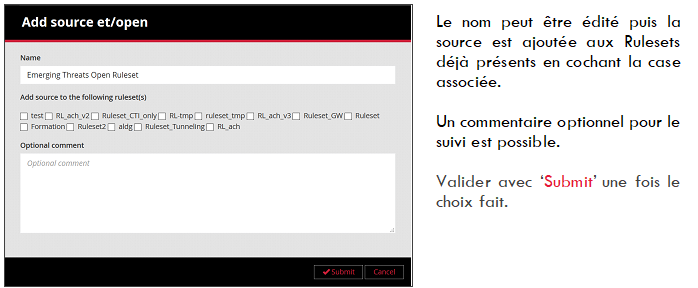
Displaying a custom rule is done from the 'View' tab in Add custom source:
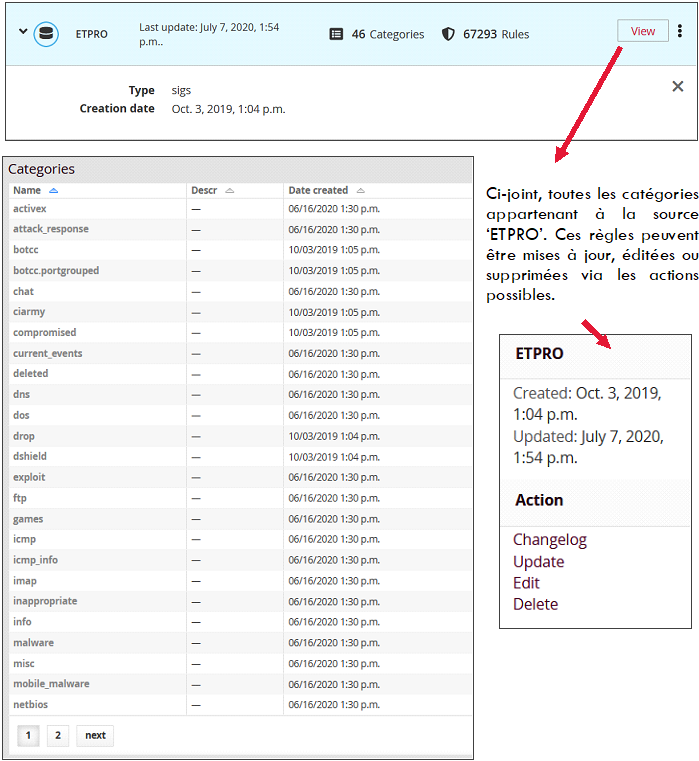
These sources update automatically in the case of public / HTTP sources if the GCENTER is connected to the internet. Otherwise, a manual update can be done on this interface in order to ensure that the latest signatures are available.
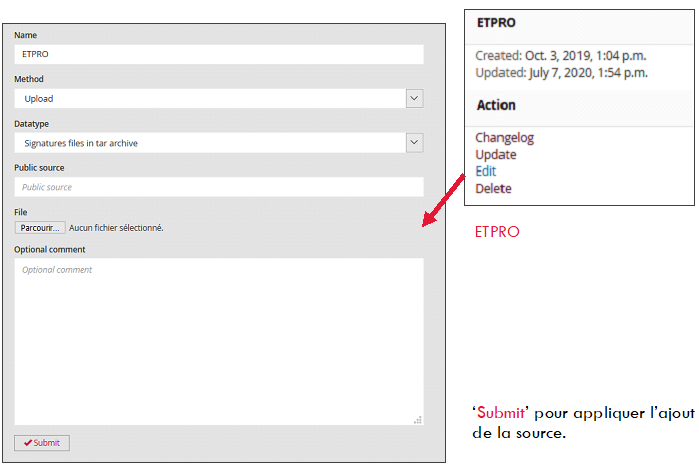
Updating signatures and checking the history of changes is possible:

3.2. Rulesets

Menu: Operators > Sigflow > Rulesets
Subsequently, a 'Ruleset' must be assigned to the previously added source. The creation of the Ruleset is mandatory in order for the GCAP probe to analyse the network flow and issue alerts if the signatures match.
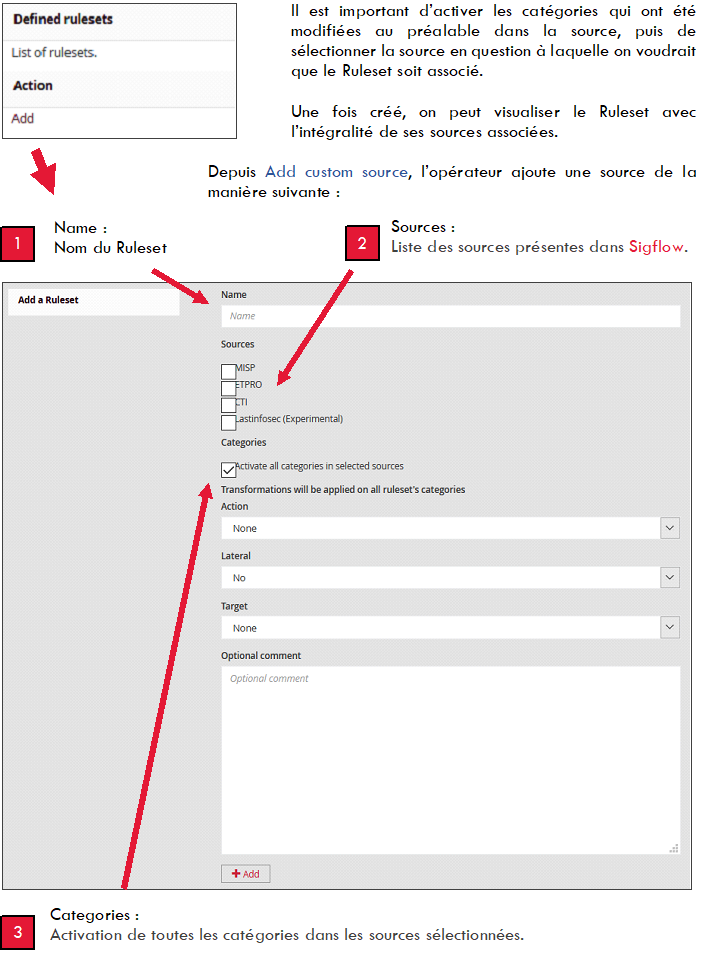
Modifications can be made to the rules in order to adapt a public rule to specific information systems or to a particular need.
The following changes will be applied to all categories of the Ruleset.
ACTION:
Determines the action to be applied to the created Ruleset.
Filestore: If a ruleset matches and contains a signature, the packet will be treated and stored like any other packet.
Reject: If the packet is rejected, Sigflow issues an alert for both reset packets (TCP) and ICMP error packets.
Drop: If it finds a matching rule containing the signature, it stops immediately. The packet will no longer be sent and an alert will be issued.
Bypass: If a rule matches and contains a 'bypass', Sigflow will stop scanning the packet and skip to the end of all rules. This will only be for the current packet.
LATERAL:
Signatures are often written with the variables $EXTERNAL\NET and $HOME\NET. This means that they will not match if both sides of a flow are in the $HOME_NET. Thus, lateral movements are not detected. This transformation changes $EXTERNAL_NET into any other variable in order to detect lateral movements.
The option can assume three values:
No: the replacement is not performed
Yes: $EXTERNAL_NET is replaced by whatever IP (any)
Auto: substitution is made if the signature checks certain properties
TARGET:
The keyword 'target' can be used to indicate which side of a flow triggering a signature is the target. If this key is present, related events are enhanced to contain the source and target of the attack.
The option can assume four values:
Auto: an algorithm is used to determine the target if one is present
Destination: the target is the receiving IP
Source: the target is the originating IP
None: no transformation is performed
'Add' to validate the insertion of the ruleset.
3.2.1. Optimisation of rulesets
As with the sources, the ruleset can update itself at any time. It thus updates all its signatures while proposing a differential of the operated changes:

A Ruleset can be edited to allow the operator to make changes to the sources, categories, or rules in the Ruleset.
ACTION EDIT SOURCES:
This option is used to manually enable or disable the action of a source on a Ruleset.
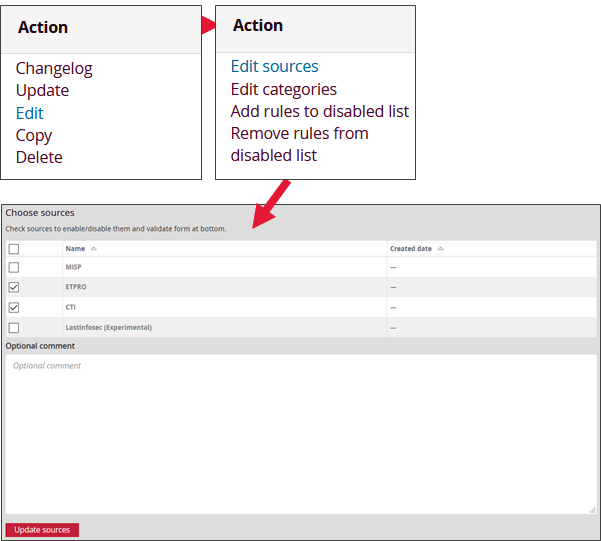
Once unticked, the signatures will no longer be matched by particular flows and no longer raise an alert on the interface.
ACTION EDIT CATEGORIES:
This option is used to manually enable or disable the action of a category on a Ruleset.
Once unticked, the signatures will no longer be matched by particular flows and no longer raise an alert on the interface.
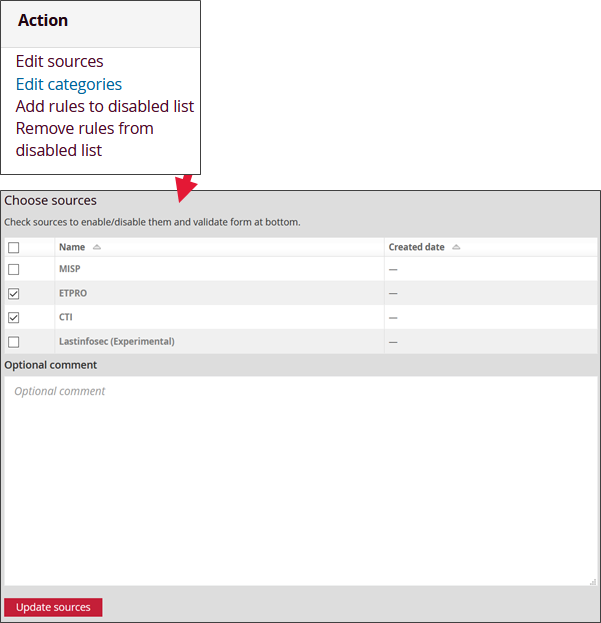
It is possible to deactivate a signature related to a Ruleset directly from the SIGFLOW interface. Deactivating a rule does not lead to its permanent deletion.
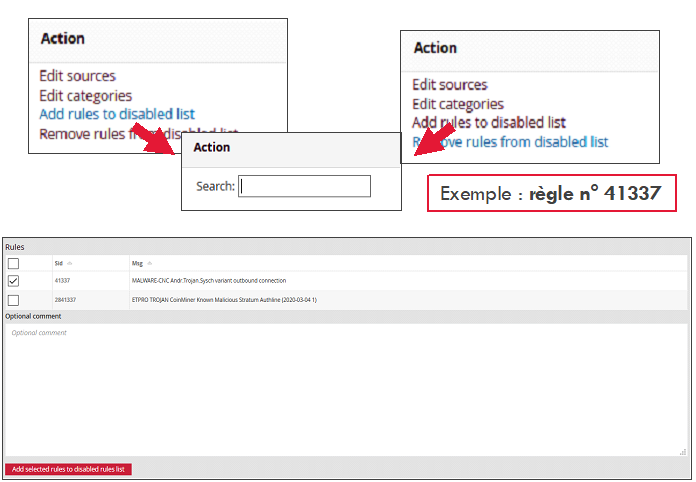
The administrator may decide to duplicate the Ruleset in order to assign it to another GCAP probe, for example, depending on the network flows that are in transit. The Ruleset is specific. It must be optimised according to the probe to which it will be assigned.
ACTION COPY RULESET:
This option is used to duplicate the Ruleset. The copy will take into account the sources associated with the Ruleset.
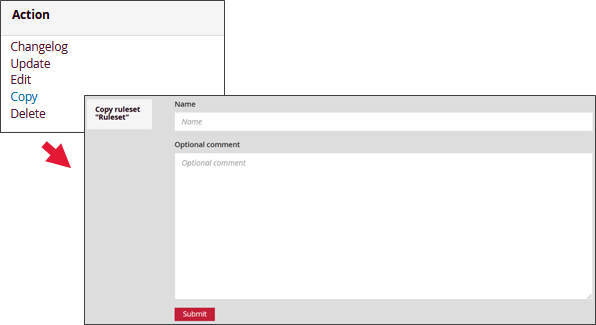
ACTION DELETE RULESET:
The deletion of the Ruleset is irreversible. However, it will not cause the deletion of the sources and signatures that were linked to the Ruleset.
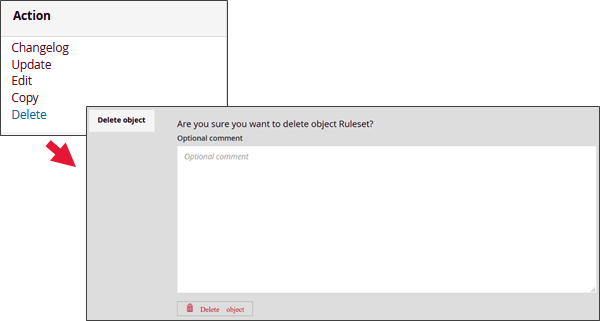
Other viewing options are available via the SIGFLOW interface. The DISPLAY section provides an overview of the categories (via Show structure) and rules (via Show rules). Moreover, thanks to this section, an export of the entire SIGFLOW configuration is possible, taking into account the Ruleset, sources, thresholds, and suppressions created.
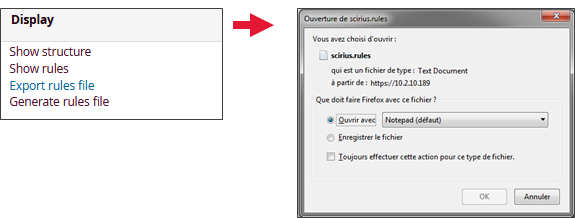
3.3. Changing signatures
Signatures and their categories are the common thread between a source and a ruleset. It is possible to directly modify the operation of a signature from the GCenter interface.
The signatures and their categories can be accessed from a Ruleset by clicking on the View button of the Ruleset and then the category.
Depending on the alerts arriving at the interface, it is possible to be quite specific about the type or even the number of notifications. The rule can be enabled or disabled within the Ruleset.

By clicking on the "Edit Rule" link it is possible to generate rules to limit or suppress certain alerts. There are Suppress Rules that remove an alert based on the source or destination IP address and Threshold Rules that limit the number of alerts to be displayed.
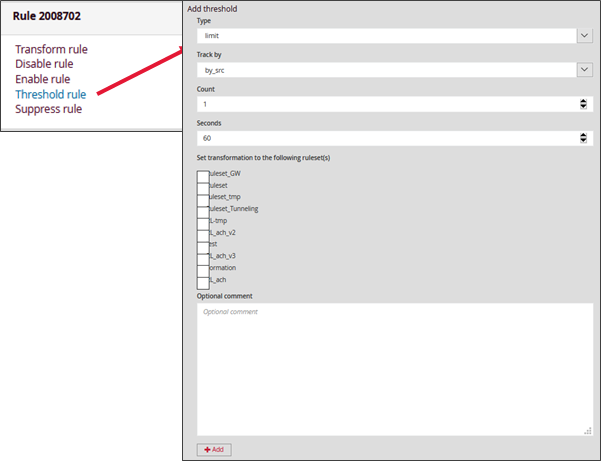
THRESHOLD:
This option is used to program a restriction of alerts above a set limit.
For a threshold, there are three types of rules:
Threshold: This type can be used to set a minimum limit for a rule before alerts are generated. A threshold setting of N indicates that the nth time the rule matches, an alert is triggered.
Limit: This type can be used to ensure that it does not overwhelm with alerts. If set to N, it will alert a maximum of N times.
Both: This type is a composite of the "threshold" and "limit" types. It applies both thresholding and limiting. This alert will only generate N alerts if, within X minutes.
Then, it is necessary to:
Define whether the alert will be based on the source or destination IP
Specify the maximum number of alerts generated for the given period
Define the period in seconds to generate the alert
The created rules are available in the Ruleset page along with the format of the new rule.
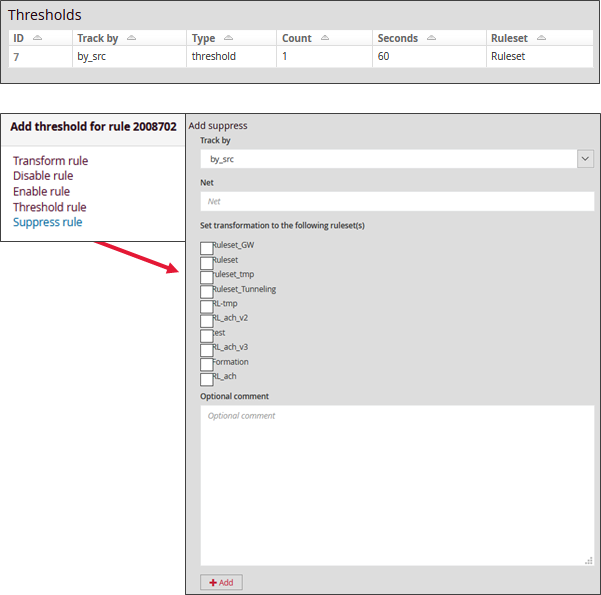
SUPPRESS:
This option provides for the removal of an alert in relation to a given IP address or network.
Multiple IPs can be added separated by ' ,'.
After selecting Suppress Rules:
Choose the Ruleset to be assigned
Choose whether the alert's suppression will be based on the source or the destination.
Define the IP relevant to this rule. (in CIDR format)
The rule is available on the Ruleset page in question:

By clicking on the ID of the suppress rule it can be edited or deleted.
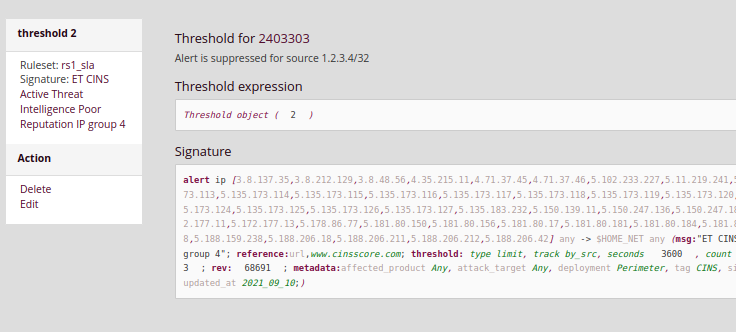
3.3.1. Definition of signatures
All the signatures present in the sources contain references leading to blogs, CVEs, and websites... accessible from the interface. To better understand how a signature works, here is an example of a rule:

In most cases, a rule, a signature is composed of: an action, the header, and rule options. For example:

The following protocols can be the subject of a rule:

In the signature, you can assign IP addresses, both IPv4 and IPv6, combined as well as separate. Both sources and destinations of the signature are affected.
Furthermore, it is possible to define variables such as $HOME_NET or $EXTERNAL_NET to which the IPs are to be defined . These variables are used to increase the accuracy of the alerts provided by the signatures.
The following syntax can be used to specify the addresses:

Similarly, the following syntax can be used to specify ports:

Two directions can be specified to indicate the direction of the flow:

3.4. Generating rulesets
Important
As long as the rulesets have not been generated after modifications, no configuration will be deployed.
Once the configuration of the sources, rulesets, and any modifications are completed, it is necessary to generate the configuration for the probes and implement it. This is accomplished by using the "Generate Ruleset" action, which will freeze the status of the Ruleset and take into account all modifications.

3.5. Secret Local Rule
It is also possible to define certain rules locally on a GCAP probe that will intentionally not appear in the GCENTER interface.
This may occur in the following instances:
Making signatures confidential without the GCENTER operators being able to see them, according to a 'need to know' concept.
Modify the local signatures of probes in complex cases.
If the GCENTER is assigned to a third party and the third party cannot handle markers or signatures of a certain level.
This is discussed in more detail in the [GCAP documentation] (https://docs.gatewatcher.com/gcap.html) in the section `Detection Engine > 7. Adding secret rules locally*".
4. Detection
4.1. SmartMap

Menu: Operators > SmartMap
The SmartMap enables real-time visualisation of attacks and traffic. This allows for intuitive and visual detection of unusual or particularly heavy traffic.
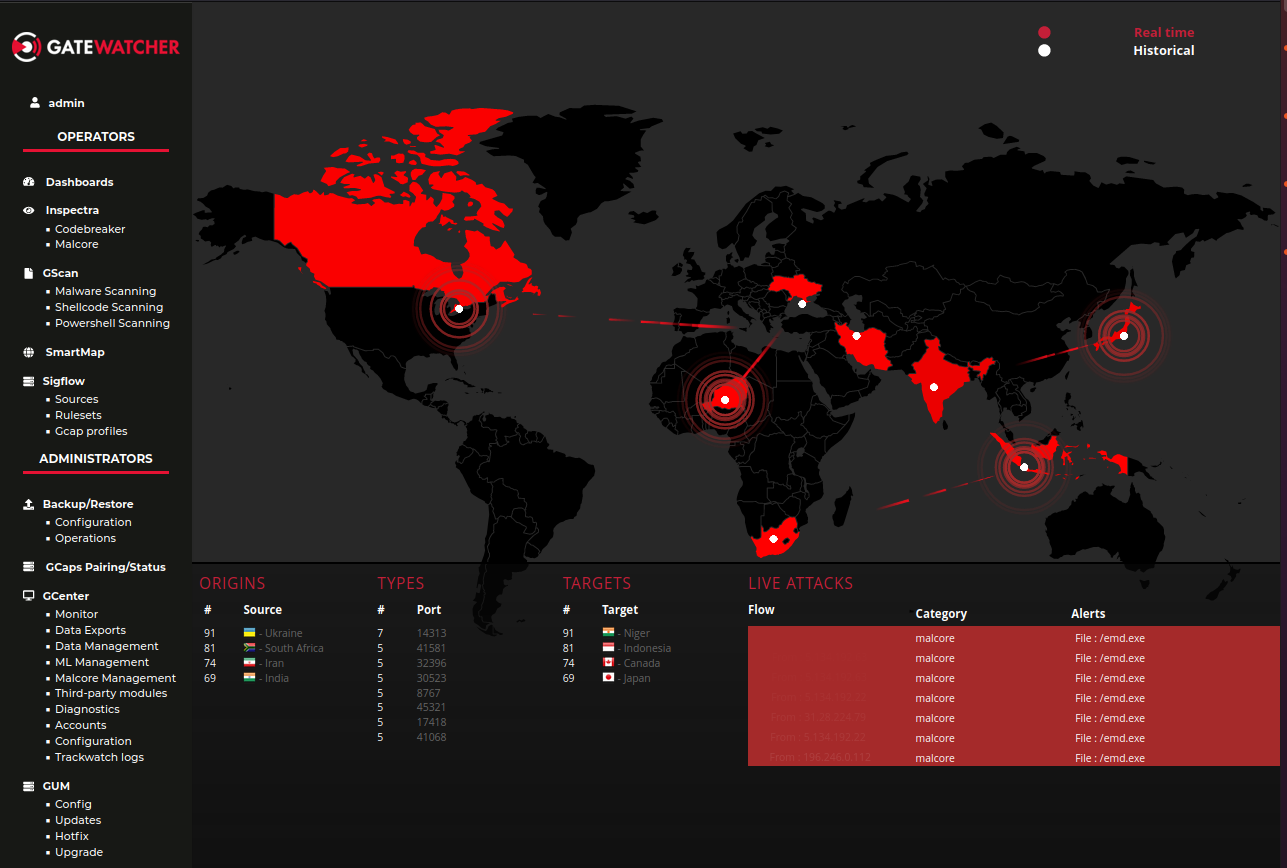
In order to display the information on the map, the SmartMap requires geolocation data on the alerts. The latter will therefore need to be activated from the configuration section by an administrator.
4.2. Kibana Dashboard

Menu: Operators > Dashboards
All the information analysed by the Sigflow module is stored in order for the operators to be able to carry out an analysis in the most efficient way possible.
Thus, various dashboards are made available by default.
The information from the Sigflow module can be found in the Tactical *dashboard. This provides a global view of the threats, including those identified by Sigflow.
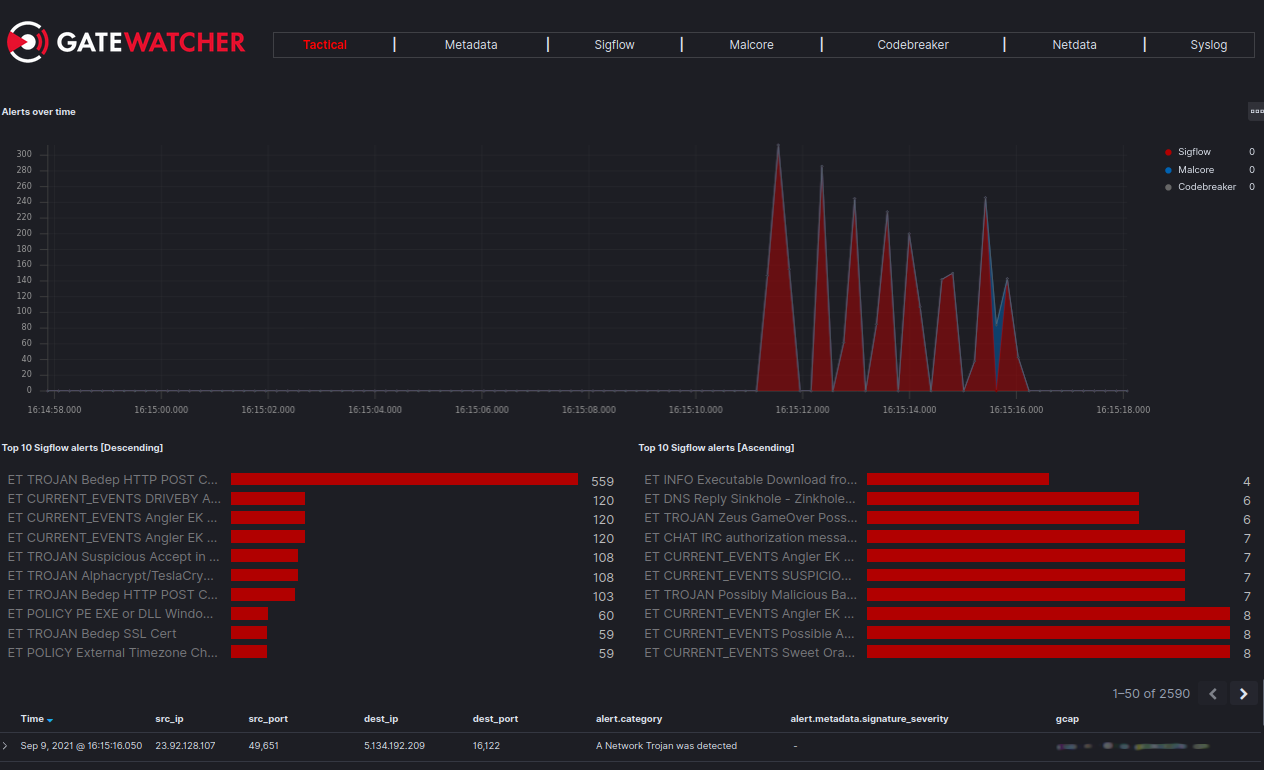
More specific data for this module can also be found in the Sigflow *dashboard.
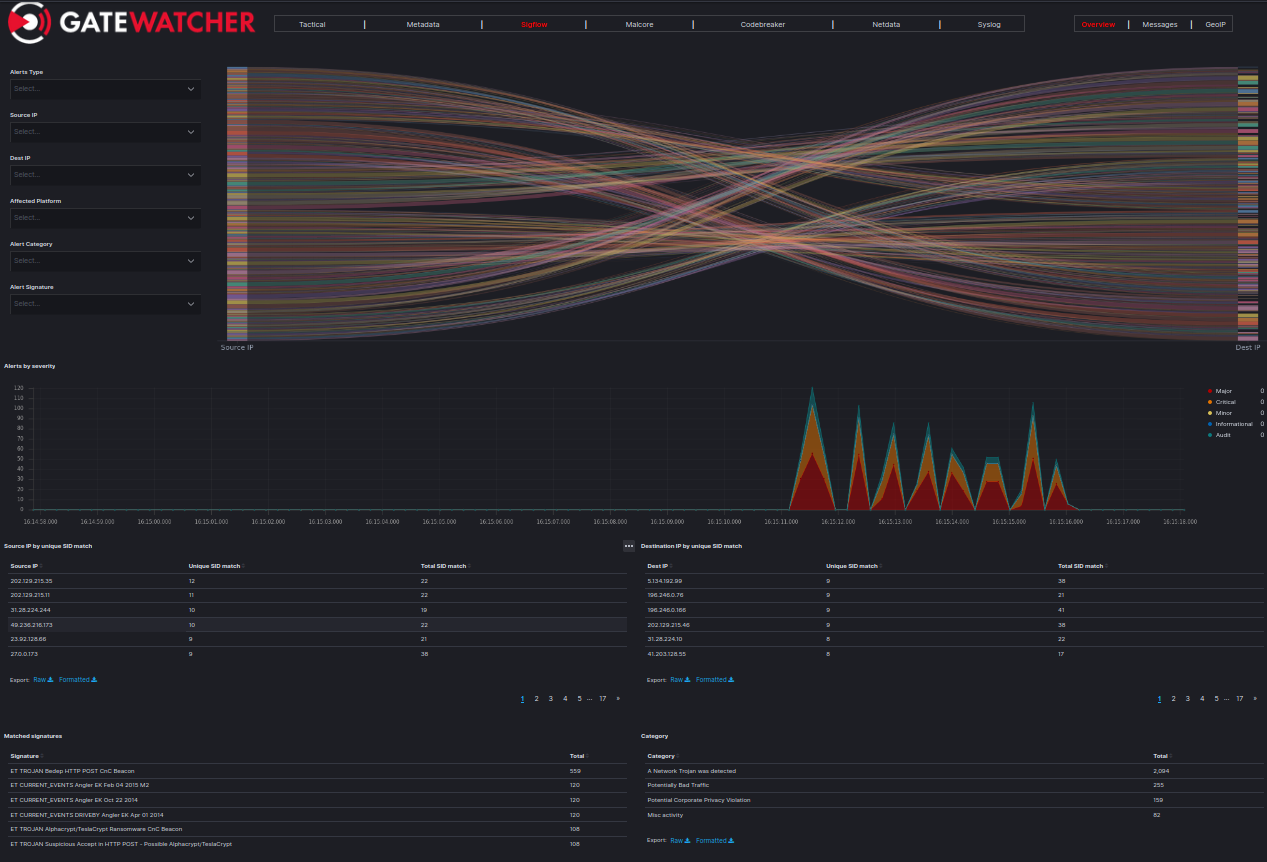
As always, it is possible to obtain the full details of the alerts by switching to the Messages view

The fields present are those detailed below in the section Generated events
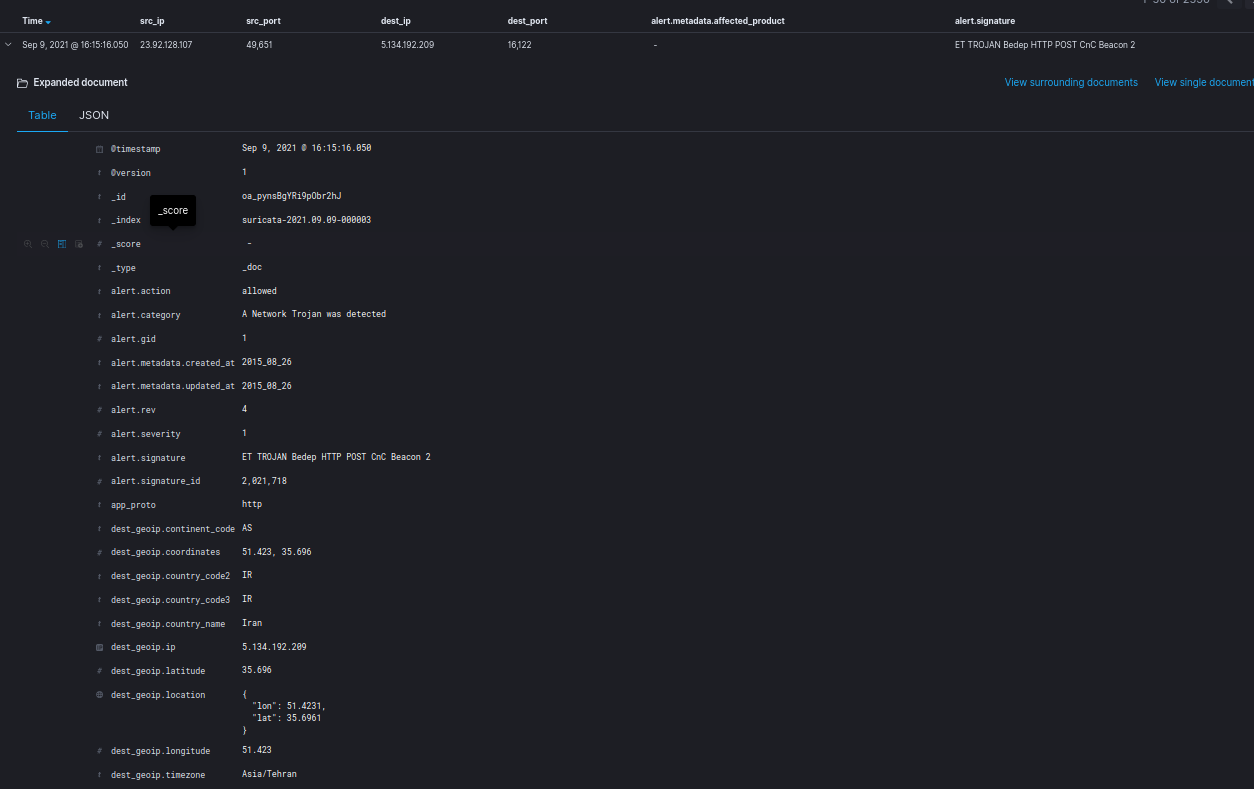
Finally, this module also enriches the observed traffic with the metadata that were analysed according to the configuration made on the GCAP profile
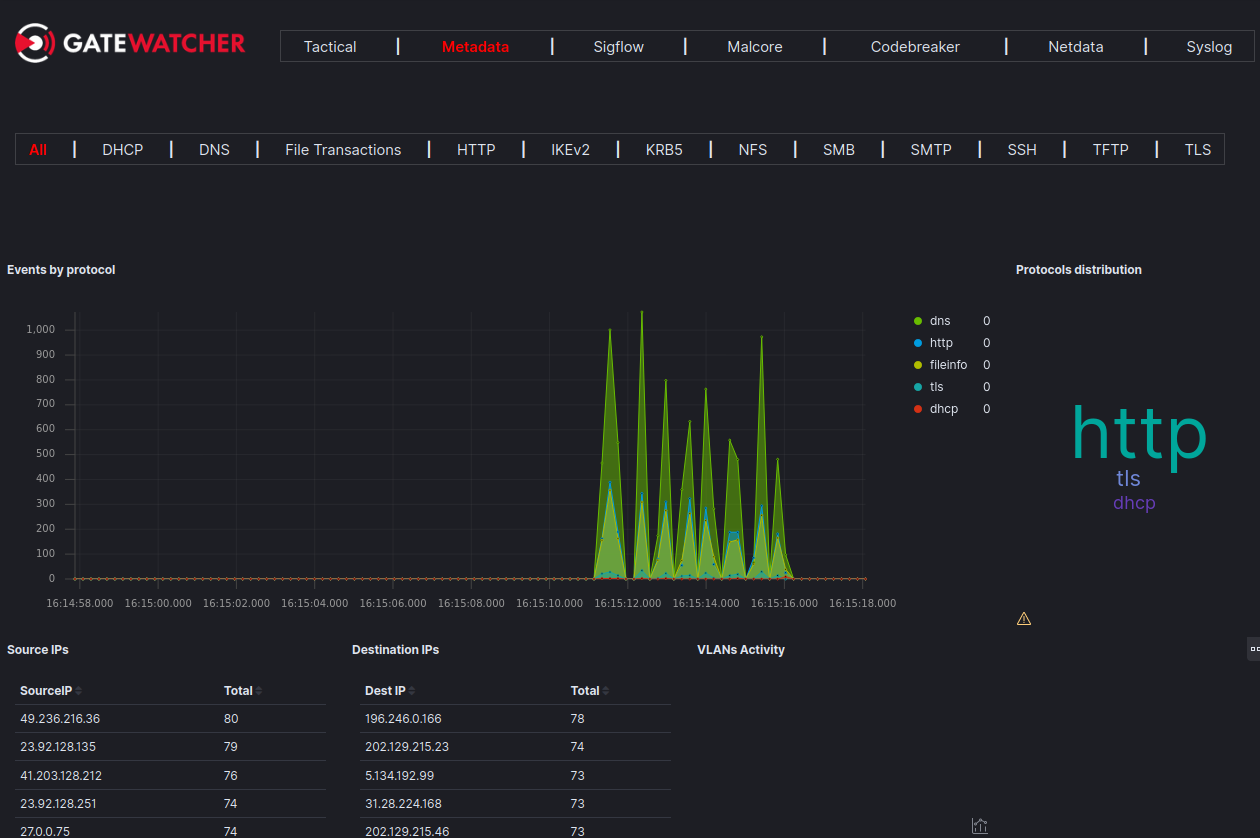
5. Generated events
For suricata, and therefore Sigflow, the fields created depend on the observed flow.
5.1. Document type "alert"
List of fields present in all alerts with event_type == alert:
@timestamp
@version
alert.action
alert.category
alert.gid
alert.rev
alert.severity
alert.signature
alert.signature_id
dest_ip
event_type
flow.bytes_toclient
flow.bytes_toserver
flow.pkts_toclient
flow.pkts_toserver
flow.start
flow_id
gcap
GCenter
host
packet
packet_info.linktype
payload_printable
proto
severity
src_ip
stream
timestamp_analyzed
timestamp_detected
type
uuid
List of protocols compatible with parsing (app_proto field):
dcerpc
dhcp
dnp3
dns
ftp
http
ikev2
krb5
modbus
nfs
ntp
smb,
smtp
ssh
tftp
tls
If a protocol changes midstream, for example if SMTP is upgraded to TLS via STARTTLS, or if the protocols used are not the same in both directions of the flow, the following fields may appear:
app_proto_tc (to client)
app_proto_ts (to server)
app_proto_orig
Summary table of fields that do not depend on the protocols:
| Fields | Required | Suricata keyword | Description |
|---|---|---|---|
| alert.action | Yes | alert, drop, reject, pass | Allowed if the alert or pass action is used; blocked if the drop or reject action is used. |
| alert.category | Yes | classtype | Description of the alert's classification. |
| alert.gid | Yes | gid | Identifier of an alert group. |
| alert.metadata | No | metadata: key value; | Alert metadata. The specification of the fields is open. |
| alert.rev | Yes | rev | Alert's revision number. |
| alert.severity | Yes | - | Severity level of the alert. |
| alert.signature | Yes | msg | Description of the alert. |
| alert.signature_id | Yes | sid | Alert identifier. It must be a unique one. |
| app_proto | No | - | Application protocol of the flow from which the file originates. |
| dest_ip | Yes | - | Destination IP address. |
| dest_port | No | - | Destination port. Only present when the value of proto is udp or tcp. |
| event_type | Yes | - | Type of event. Alert by default. |
| flow.age | No | - | Flow duration. |
| flow.bytes_toclient | Yes | - | Size of the flow to the client. |
| flow.bytes_toserver | Yes | - | Size of the flow to the server. |
| flow.end | No | - | Date and time of the last package seen by suricata. |
| flow.pkts_toclient | Yes | - | Number of packets to the client. |
| flow.pkts_toserver | Yes | - | Number of packets to the server. |
| flow.reason | No | - | Mechanism causing the flow to stop processing between ("timeout", "forced", and "shutdown") |
| flow.start | Yes | - | Date and time of the first package seen by suricata. |
| flow.state | No | - | The status of the flow between ("new", "established", "closed", "bypassed") |
| file_id | Yes | - | Flow identifier. |
| gcap | Yes | - | Name of the gcap assigned to the alert. |
| gcenter | Yes | - | Name of the GCenter assigned to the alert. |
| host | Yes | - | Name of the gcap assigned to the alert. |
| in_iface | No | Capture interface on the gcap. | |
| packet | No | - | Package in base64 format. Only present if the packet option in the gcap "variable bases" menu is enabled. |
| payload | No | - | Payload in base64 format. Only present if the payload option in the gcap "variable bases" menu is enabled. |
| packet_info.linktype | Yes | - | - |
| payload_printable | No | - | Package payload in a readable format. Only present if the payload-printable option in the gcap "variable bases" menu is enabled. |
| proto | Yes | - | Layer 4 protocol used. |
| severity | Yes | - | Severity level of the alert. |
| src_ip | Yes | - | Destination IP address. |
| src_port | No | - | Destination port. Only present when the value of proto is udp or tcp. |
| stream | Yes | - | - |
| timestamp_analyzed | Yes | - | Date and time of the alert analysis by logstash. |
| timestamp_detected | Yes | - | Date and time of suricata generated the alert. |
| type | Yes | Type of event. Suricata by default. | |
| uuid | Yes | - | Unique alert identifier. |
| vlan | No | - | Vlan identifier of the flow. |
List of metadata used in the source alerts (alert.metadata object in ES):
alert.metadata.affected_product
alert.metadata.attack_target
alert.metadata.created_at
alert.metadata.deployment
alert.metadata.former_category
alert.metadata.impact_flag
alert.metadata.malware_family
alert.metadata.performance_impact
alert.metadata.ruleset
alert.metadata.service
alert.metadata.signature_severity
alert.metadata.tag
alert.metadata.updated_at
Here is an example of an alert using the metadata affected_product, attack_target, created_at, deployment, signature_severity, tag and updated_at:
alert tcp $EXTERNAL_NET any -> $SQL_SERVERS 1433 (
msg:"ET EXPLOIT MS-SQL SQL Injection closing string plus line comment";
flow: to_server,established;
content:"'|00|";
content:"-|00|-|00|";
reference:url,doc.emergingthreats.net/bin/view/Main/2000488;
classtype:attempted-user;
sid:2000488;
rev:7;
metadata:affected_product Web_Server_Applications, attack_target Web_Server, created_at 2010_07_30, deployment Datacenter, signature_severity Major, tag SQL_Injection, updated_at 2016_07_01;
)
5.2. Document type "fileinfo"
List of fields present in all alerts with event_type == fileinfo:
@timestamp
@version
app_proto
dest_ip
dest_port
event_type
fileinfo.filename
fileinfo.gaps
fileinfo.size
fileinfo.state
fileinfo.stored
fileinfo.tx_id
flow_id
gcap
GCenter
host
proto
src_ip
src_port
timestamp_analyzed
timestamp_detected
type
uuid
Summary table of fields that do not depend on the protocols:
| Fields | Required | Description |
|---|---|---|
| app_proto | Yes | Application protocol of the flow from which the file originates. |
| dest_ip | Yes | Destination's IP address. |
| dest_port | Yes | Destination port. Only present when the value of proto is udp or tcp. |
| event_type | Yes | Type of event. |
| fileinfo.file_id | No | File identifier. |
| fileinfo.filename | Yes | File name. |
| fileinfo.gaps | Yes | - |
| fileinfo.magic | No | File type identifier. |
| fileinfo.md5 | No | Hash MD5 of the file. |
| fileinfo.sha1 | No | Hash SHA1 of the file. |
| fileinfo.sha256 | No | Hash SHA256 of the file. |
| fileinfo.size | Yes | File size. |
| fileinfo.state | Yes | Completeness of the analysed file (CLOSED) otherwise TRUNCATED. The file-store.stream-depth variable of suricata defines the size of the reconstructed files. The file is TRUNCATED if its size is > File-store stream-depth (10 MB) by default. |
| fileinfo.stored | Yes | True if the file is rebuilt and False otherwise. |
| fileinfo.tx_id | Yes | - |
| file_id | Yes | Flow identifier. |
| gcap | Yes | Name of the gcap assigned to the alert. |
| gcenter | Yes | Name of the GCenter assigned to the alert. |
| host | Yes | Name of the gcap assigned to the alert. |
| in_iface | No | Capture interface on the gcap. |
| proto | Yes | Layer 4 protocol used. |
| src_ip | Yes | Destination IP address. |
| src_port | No | Destination port. Only present when the value of proto is udp or tcp. |
| timestamp_analyzed | Yes | Date and time of the alert analysis by logstash. |
| timestamp_detected | Yes | Date and time of suricata generated the alert. |
| type | Yes | Type of event. Suricata by default. |
| uuid | Yes | Unique alert identifier. |
| vlan | No | Vlan identifier of the flow. |
5.3. Metadata document
List of fields present in all alerts with event_type != ["alert", "fileinfo", "stats"]:
@timestamp
@version
dest_ip
event_type
flow_id
gcap
GCenter
host
proto
src_ip
timestamp_analyzed
timestamp_detected
type
uuid
List of protocols compatible with logging (champ event_type):
dhcp:
dhcp.assigned_ip
dhcp.client_ip
dhcp.client_mac
dhcp.dhcp_type
dhcp.dns_servers
dhcp.hostname
dhcp.id
dhcp.lease_time
dhcp.next_server_ip
dhcp.params
dhcp.rebinding_time
dhcp.relay_ip
dhcp.renewal_time
dhcp.requested_ip
dhcp.routers
dhcp.subnet_mask
dhcp.type
dnp3
dns:
body.proba_dga
body.severity
dga_probability
dns.aa
dns.answers.rdata
dns.answers.rrname
dns.answers.rrtype
dns.answers.ttl
dns.authorities.rrname
dns.authorities.rrtype
dns.authorities.ttl
dns.flags
dns.grouped.A
dns.grouped.AAAA
dns.grouped.CNAME
dns.id
dns.qr
dns.ra
dns.rcode
dns.rd
dns.rrname
dns.rrtype
dns.tx_id
dns.type
dns.version
headers.content-length
headers.content-type
tags
ftp
http:
http.accept
http.accept-charset
http.accept-datetime
http.accept_encoding
http.accept_language
http.accept-range
http.age
http.allow
http.authorization
http.cache_control
http.connection
http.content_encoding
http.content-language
http.content-length
http.content-location
http.content-md5
http.content-range
http.content_type
http.content-type
http.cookie
http.date
http.dnt
http.etags
http.from
http.hostname
http.http_content_type
http.http_method
http.http_port
http.http_refer
http.http_user_agent
http.last-modified
http.length
http.link
http.location
http.max-forwards
http.origin
http.pragma
http.proxy-authenticate
http.proxy-authorization
http.range
http.redirect
http.referrer
http.refresh
http.retry-after
http.server
http.set-cookie
http.status
http.te
http.trailer
http.transfer-encoding
http.upgrade
http.url
http.vary
http.via
http.warning
http.www-authenticate
http.x-authenticated-user
http.x-flash-version
http.x-forwarded-proto
http.x-requested-with
ikev2:
ikev2.alg_auth
ikev2.alg_dh
ikev2.alg_enc
ikev2.alg_esn
ikev2.alg_prf
ikev2.errors
ikev2.exchange_type
ikev2.init_spi
ikev2.message_id
ikev2.notify
ikev2.payload
ikev2.resp_spi
ikev2.role
ikev2.version_major
ikev2.version_minor
krb5:
krb5.cname
krb5.encryption
krb5.error_code
krb5.failed_request
krb5.msg_type
krb5.realm
krb5.sname
krb5.weak_encryption
netflow:
icmp_code
icmp_type
metadata.flowbits
netflow.age
netflow.bytes
netflow.end
netflow.max_ttl
netflow.min_ttl
netflow.pkts
netflow.start
parent_id
tcp.ack
tcp.cwr
tcp.ecn
tcp.fin
tcp.psh
tcp.rst
tcp.syn
tcp.tcp_flags
nfs:
nfs.file_tx
nfs.filename
nfs.hhash
nfs.id
nfs.procedure
nfs.rename.from
nfs.rename.to
nfs.status
nfs.type
nfs.version
rpc.auth_type
rpc.creds.gid
rpc.creds.machine_name
rpc.creds.uid
rpc.status
rpc.xid
smb:
smb.access
smb.accessed
smb.changed
smb.client_dialects
smb.client_guid
smb.command
smb.created
smb.dcerpc.call_id
smb.dcerpc.interfaces.ack_reason
smb.dcerpc.interfaces.ack_result
smb.dcerpc.interfaces.uuid
smb.dcerpc.interfaces.version
smb.dcerpc.opnum
smb.dcerpc.req.frag_cnt
smb.dcerpc.req.stub_data_size
smb.dcerpc.request
smb.dcerpc.res.frag_cnt
smb.dcerpc.res.stub_data_size
smb.dcerpc.response
smb.dialect
smb.directory
smb.disposition
smb.filename
smb.fuid
smb.function
smb.id
smb.modified
smb.named_pipe
smb.ntlmssp.domain
smb.ntlmssp.host
smb.ntlmssp.user
smb.request.native_lm
smb.request.native_os
smb.response.native_lm
smb.response.native_os
smb.server_guid
smb.service.request
smb.service.response
smb.session_id
smb.share
smb.share_type
smb.size
smb.status
smb.status_code
smb.tree_id
smtp:
email.attachment
email.body_md5
email.from
email.status
email.subject
email.subject_md5
email.to
smtp.helo
smtp.mail_from
smtp.rcpt_to
ssh:
ssh.client.proto_version
ssh.client.software_version
ssh.server.proto_version
ssh.server.software_version
tftp:
tftp.file
tftp.mode
tftp.packet
tls:
tls.chain
tls.fingerprint
tls.issuerdn
tls.notafter
tls.notbefore
tls.sni
tls.subject
tls.version
Summary table of fields that do not depend on the protocols:
| Fields | Required | Description |
|---|---|---|
| app_proto | No | Application protocol of the flow from which the file originates. |
| dest_ip | Yes | Destination's IP address. |
| dest_port | No | Destination port. Only present when the value of proto is udp or tcp. |
| event_type | Yes | Type of event. Alert by default. |
| file_id | Yes | Flow identifier. |
| gcap | Yes | Name of the gcap assigned to the alert. |
| gcenter | Yes | Name of the GCenter assigned to the alert. |
| host | Yes | Name of the gcap assigned to the alert. |
| in_iface | No | Capture interface on the gcap. |
| proto | Yes | Layer 4 protocol used. |
| src_ip | Yes | Destination IP address. |
| src_port | No | Destination port. Only present when the value of proto is udp or tcp. |
| timestamp_analyzed | Yes | Date and time of the alert analysis by logstash. |
| timestamp_detected | Yes | Date and time of suricata generated the alert. |
| type | Yes | Type of event. Suricata by default. |
| uuid | Yes | Unique alert identifier. |
| vlan | No | Vlan identifier of the flow. |